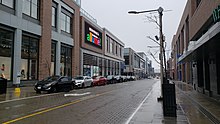Lansdowne Park redevelopment
In September 2007, cracks were discovered in Frank Clair Stadium, and a portion of the south-side stands was demolished due to safety concerns.
The redevelopment plan was split into two components after the City rejected the portion of the OSEG proposal regarding lands bordering the Rideau Canal.
Other alternatives proposed including building a football stadium at another more suitable location and organizing the park reconstruction solely as a public process.
[1] A proposal was received to convert most of the lands into a residential development, retain the Aberdeen Pavilion and Civic Centre and return money to the City of Ottawa.
[3] Ottawa mayor Larry O'Brien suggested that local developers be invited to submit proposals to redevelop the area.
Before completing the Request for Proposal, the Design Lansdowne process was suspended in June 2008 while studies were done whether the Stadium and arena were worth saving.
[9] In the fall of 2007, the OSEG group had announced that it would seek the CFL franchise, and intended to play in an upgraded Frank Clair Stadium, with private boxes and other amenities.
[12] The suspension upset the Glebe Association and Capital Ward councillor Clive Doucet, and prompted Mayor O'Brien to muse "whether or not the city wants or needs a sports stadium on the prime real estate site at all."
Results of a survey of Ottawans showed strong support for a public redevelopment of the Park not tied to a professional sports franchise, although a majority of respondents were in favour of retention of the stadium.
[14] The land, being used as a snow dump,[15] would house a 20,000 seat stadium, with 30,000 for concerts, and utilize the parking spaces of Scotiabank Place.
[16] The Lansdowne Live proposal envisioned rebuilding Frank Clair Stadium to support not only Canadian Football, but also professional soccer.
Early versions of the plan included practice baseball fields, soccer pitches, a Koi pond, a walk-through aquarium in Aberdeen Pavilion and an outdoor amphitheatre.
The City held public hearings based on the report, which questioned the necessity of the spending, but gave a slight edge to the Lansdowne proposal.
Council imposed conditions on the negotiations, including preserving the farmer's market, turning a substantial portion of the site into greenspace and public use areas, no big-box stores and city approval for any buildings.
[24] The jury deliberated until June 8 before choosing the "Win-Place-Show" proposal developed by Vancouver landscape architects Phillips Farevaag Smallenberg.
[26] On June 28, 2010, after reviewing several studies on the proposal, City of Ottawa Council voted to proceed with sole source negotiations with OSEG.
The move, approved at committee by the tie-breaking vote of mayor O'Brien, included the lands of Sylvia Holden Park along Bank Street and Holmwood Avenue.
[32] Later in October, the municipal election was held and Lansdowne Park was one of the issues, both locally in Capital Ward and across the city in the vote for mayor.
In August 2009, Glebe businessman John E. Martin, made a proposal to build a new stadium and library/cultural centre on city-owned property on Bayview Avenue in Mechanicsville.
At Lansdowne Park, Frank Clair Stadium North Stands would be kept and refurbished, the hockey arena retained and the South stands taken down and left down, heritage buildings would be kept in place, renovated and converted into retail and service-related space and the rest of the site greened with a concert shell, horticulture area and outdoor pool.
[45] The Lansdowne Park Conservancy (LPC) proposal and competitive bid was established in March 2010[46] to provide an alternative option to the sole-sourced OSEG plan.
On September 14, 2010, LPC presented a preview of the revised proposal to the planning and environment committee of Ottawa City Council.
The second alternative would see an RFP for a stadium-tied development on the vacant City lot at Bayview and Scott Street ( adjacent to the Ottawa River near LeBreton Flats).
In a November 18, 2010 letter to the LPC: "Your submission is not timely having regard to the fact Council already granted approvals pertaining to the Lansdowne Partnership Plan going back to June 28, 2010."
The Conservancy filed a lawsuit seeking open bidding, but the Ontario Superior Court rejected the suit as an abuse of process on March 23, 2012.
A competitive process would require competing proposals to the Lansdowne Live project and invite bidding for the park redevelopmentk.
[64] Glebe resident Ian Lee, who runs the MBA program at Carleton University's Sprott School of Business, was critical of the cost of the project.
However, Lee contends that the auditor-general should have remained neutral and uninvolved, and subsequently, he filed a complaint with the Canadian Institute of Chartered Accountants.
Although the Friends did not launch a counter-proposal, the Friends advocated for a revitalization of Lansdowne Park based on principles developed through a process involving "significant and meaningful public consultation, a fair, open design competition to revitalize Lansdowne Park – like the one Council interrupted" and "a sustainable design.
[70] A court challenge was launched by Gary Sealey, Doug Ward, and the "Friends of Lansdowne" in September 2010, seeking to overturn the partnership plan on the grounds that city rules were not followed in the sole-source process.






